
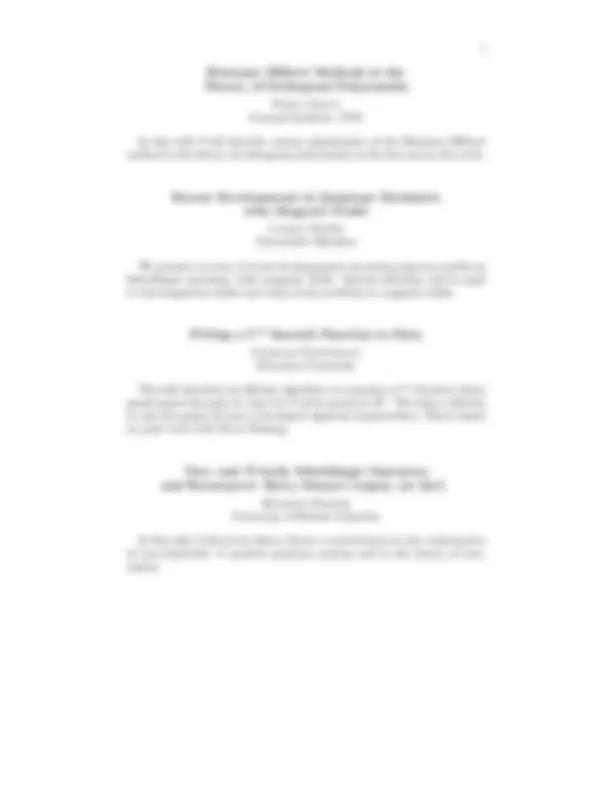
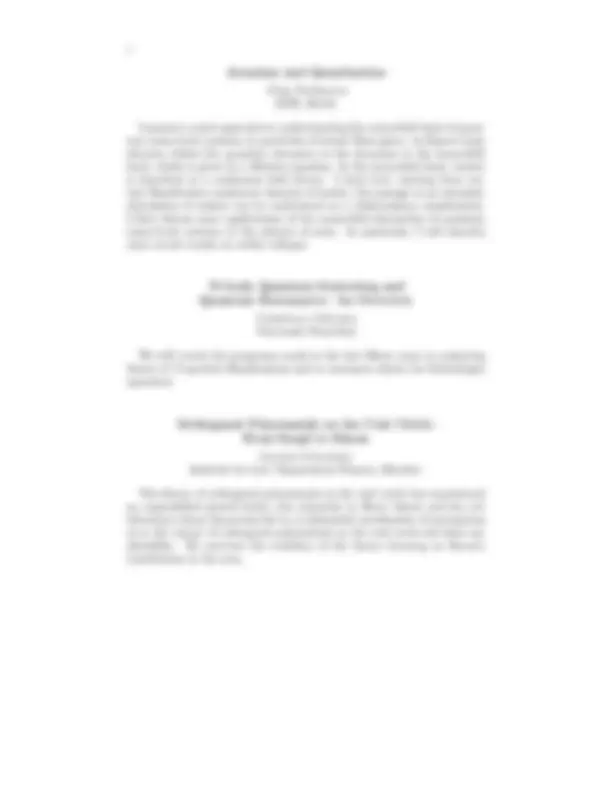
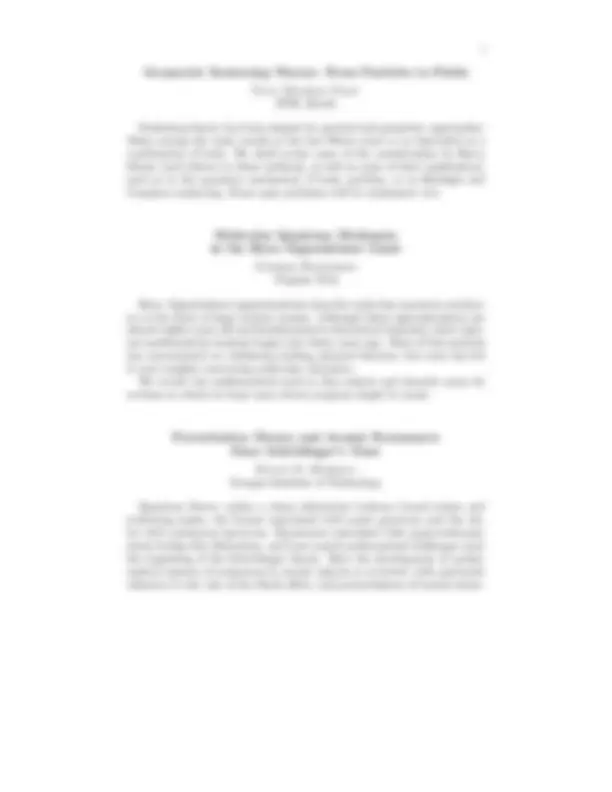
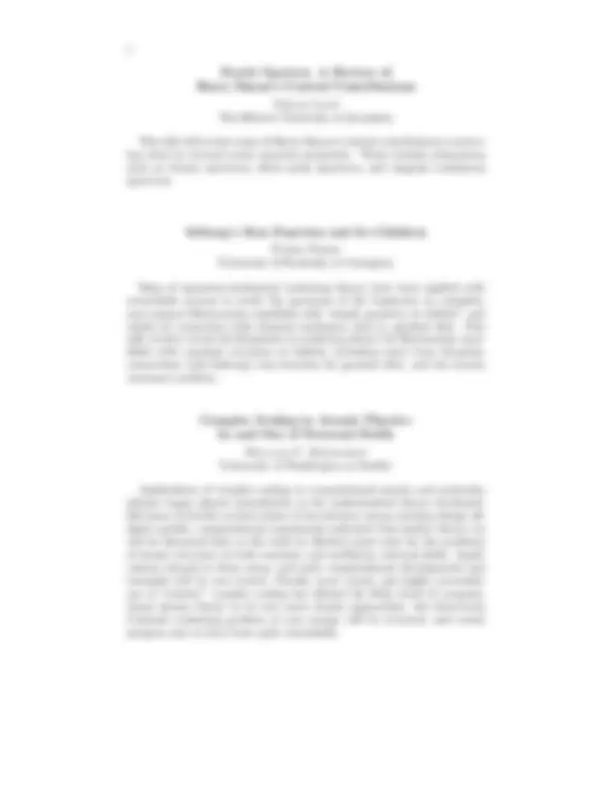
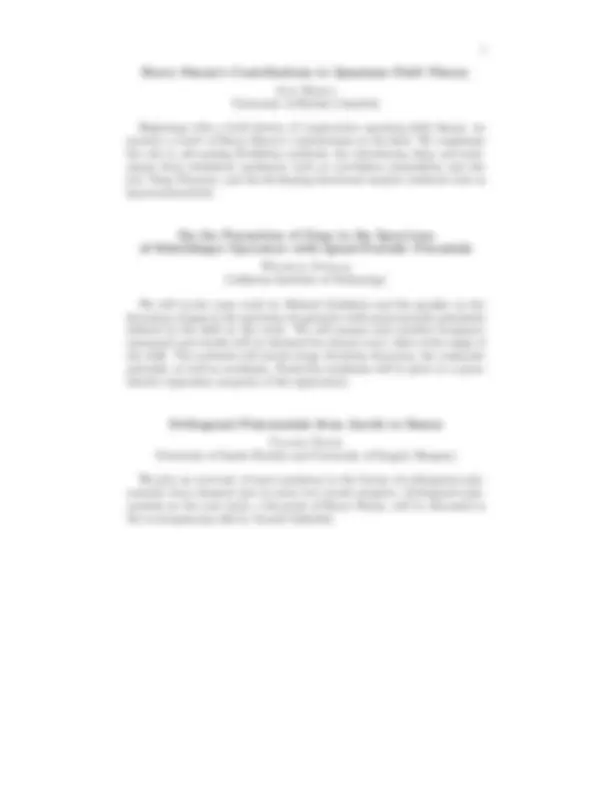


Study with the several resources on Docsity

Earn points by helping other students or get them with a premium plan


Prepare for your exams
Study with the several resources on Docsity

Earn points to download
Earn points by helping other students or get them with a premium plan
Community
Ask the community for help and clear up your study doubts
Discover the best universities in your country according to Docsity users
Free resources
Download our free guides on studying techniques, anxiety management strategies, and thesis advice from Docsity tutors
Perturbation Theory and Atomic Resonances. Since Schrödinger's Time. Evans M. Harrell. Georgia Institute of Technology. Quantum theory makes a sharp ...
Typology: Lecture notes
1 / 9

This page cannot be seen from the preview
Don't miss anything!






SimonFest California Institute of Technology March 27 – 31, 2006
Michael Aizenman Princeton University
SimonFest offers an opportunity to reminisce about the contribution of “soft” methods in the study of critical phenomena in Statistical Mechanics— methods which have been warmly embraced by Barry Simon and signifi- cantly advanced in his work on the subject. In addition to a partial review of the results derived at that period, I shall describe also some related re- cent results. The latter includes a spillover of statistical mechanics insights into the analysis of Schr¨odinger operators, and also the recent proofs by M. Heydenreich and R.W. van der Hofstad, and of the speaker with V. Pap- athanakos, of a long outstanding conjecture concerning a drastic effect of the boundary conditions (periodic versus bulk/free) on the nature of the scaling limits of critical models, in particular above the upper-critical dimensions.
Yosi Avron Technion – Israel Institute of Technology
I shall review the geometric approach to the integer quantum Hall effect. In particular, I shall survey joint work with Barry Simon and Ruedi Seiler on the interpretation of the Hall conductance as an index.
Alexei Borodin California Institute of Technology
Measures on partitions with weights given by suitable products of Schur symmetric functions have recently found a variety of applications from Toeplitz determinants to representation theory, stochastic growth processes, 1
and random tiling models. The goal of the talk is to give a survey of known results on such measures.
Jean Bourgain Institute for Advanced Study, Princeton
Using combinatorial techniques such as the sum-product phenomenon in finite fields, we exhibit new classes of expanders in SL^2 (p) and SU (2). Vari- ous applications are given, in particular, to the quaquaversal tiling problem.
David Damanik California Institute of Technology
The spectral analysis of an ergodic family of one-dimensional Schr¨odinger operators typically starts out with an investigation of the Lyapunov expo- nent of the associated energy-indexed Schr¨odinger cocycle over the given ergodic transformation. For example, the absolutely continuous spectrum is given by the essential closure of the set of energies for which the Lya- punov exponent vanishes. We review some general results in this context, particularly Kotani theory, and their application to concrete models.
E B Davies King’s College, London
The theory of pseudospectra has grown rapidly since its emergence from within numerical analysis around 1990. We describe some of its applications to the stability theory of differential operators, to WKB analysis and even to orthogonal polynomials. Although currently more a way of looking at non-self-adjoint operators than a list of theorems, its future seems to be assured by the growing number of problems in which the ideas are clearly of relevance.
J¨urg Fr¨ohlich ETH, Z¨urich
I present a novel approach to understanding the mean-field limit of quan- tum many-body systems, in particular of atomic Bose gases. An Egorov-type theorem relates the quantum dynamics to the dynamics in the mean-field limit, which is given by a Hartree equation. In the mean-field limit, matter is described as a continuum field theory. I show how, starting from cer- tain Hamiltonian continuum theories of matter, the passage to an atomistic description of matter can be understood as a (deformation) quantization. I then discuss some applications of the mean-field description of quantum many-body systems to the physics of stars. In particular, I will describe some recent results on stellar collapse.
Christian G´erard Universit´e Paris-Sud
We will review the progresses made in the last fifteen years in scattering theory of N -particle Hamiltonians and in resonance theory for Schr¨odinger operators.
Leonid Golinskii Institute for Low Temperature Physics, Kharkov
The theory of orthogonal polynomials on the unit circle has experienced an unparalleled growth lately, due primarily to Barry Simon and his col- laborators whose discoveries led to a substantial reevaluation of perceptions as to the nature of orthogonal polynomials on the unit circle and their ap- plicability. We overview the evolution of the theory focusing on Simon’s contribution in the area.
Gian Michele Graf ETH, Z¨urich
Scattering theory has been shaped by spectral and geometric approaches. Many among the main results in the last fifteen years or so depended on a combination of both. We shall review some of the contributions by Barry Simon (and others) to these methods, as well as some of their applications, such as to the quantum mechanical N -body problem, or to Rayleigh and Compton scattering. Some open problems will be mentioned, too.
George Hagedorn Virginia Tech
Born–Oppenheimer approximations describe molecular quantum mechan- ics in the limit of large nuclear masses. Although these approximations are almost eighty years old and fundamental to theoretical chemistry, their rigor- ous mathematical analysis began only thirty years ago. Most of this analysis has concentrated on validating existing physical theories, but some has led to new insights concerning molecular dynamics. We review the mathematical work in this subject and describe some di- rections in which we hope some future progress might be made.
Evans M. Harrell Georgia Institute of Technology
Quantum theory makes a sharp distinction between bound states and scattering states, the former associated with point spectrum and the lat- ter with continuous spectrum. Resonances associated with quasi-stationary states bridge this distinction, and have posed mathematical challenges since the beginning of the Schr¨odinger theory. Here the development of mathe- matical aspects of resonances in atomic physics is reviewed, with particular reference to the role of the Stark effect, and perturbations of bound states.
Sergey Khrushchev Atilim University, Ankara, Turkey
It is standard to refer to Chebychev, Gauss and Jacobi as the creators of Orthogonal Polynomials. In fact, this topic goes back to the very early times of analysis, namely to March of 1655 when Wallis completed his fa- mous book “Arithmetica of Infinitorum.” This book contained a remarkable Section 191, in which Wallis presented his understanding of a solution to the functional equation b(s)b(s + 2) = (s + 1)^2 found by Brouncker. Wallis’ presentation was not very clear and posed questions on Brouncker’s proof rather than explaining it. Later in his main paper on Continued Fractions (1739), Euler paid great attention to this result of Brouncker and mentioned that it would be highly desirable to recover Brouncker’s original arguments. In this talk, we present such a recovery and show how this problem is related to orthogonal polynomials.
Rowan Killip UCLA
I will describe some examples of sum rules—simple equations relating the coefficients of operators to their spectral data—and outline their applications in forward/inverse spectral analysis.
Alexander Kiselev University of Wisconsin at Madison
We will review recent results on the imbedded singular spectrum. This will include examples with a dense set of imbedded eigenvalues, and exam- ples where wave operators exist but are not asymptotically complete due to the presence of a singular continuous spectrum. We will also discuss esti- mates on the size of the set where the singular spectrum may be supported, which can be thought of as nonlinear versions of well-known estimates for the Fourier transform.
Yoram Last The Hebrew University of Jerusalem
The talk will review some of Barry Simon’s central contributions concern- ing what he termed exotic spectral properties. These include phenomena such as Cantor spectrum, thick point spectrum, and singular continuous spectrum.
Peter Perry University of Kentucky at Lexington
Ideas of quantum-mechanical scattering theory have been applied with remarkable success to study the spectrum of the Laplacian on complete, non-compact Riemannian manifolds with “simple geometry at infinity” and clarify its connection with classical mechanics, that is, geodesic flow. This talk reviews recent developments in scattering theory for Riemannian man- ifolds with constant curvature at infinity, including exact trace formulas, connections with Selberg’s zeta function for geodesic flow, and the inverse resonance problem.
William P. Reinhardt University of Washington at Seattle
Applications of complex scaling in computational atomic and molecular physics began almost immediately as the mathematical theory developed: life-times of doubly excited states of two-electron atoms starting things off. Quite quickly, computational experiments indicated that similar theory (as will be discussed later in the week by Herbst) must exist for the problems of atomic structure in both constant, and oscillatory external fields. Appli- cations abound in these areas, and early computational developments and examples will be over-viewed. Finally, more recent, and highly successful, use of “exterior” complex scaling has allowed the Holy Grail of computa- tional atomic theory to be ever more closely approached: the three-body Coulomb scattering problem at zero energy will be reviewed, and recent progress seen to have been quite remarkable.